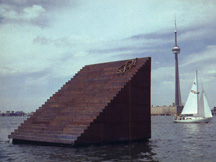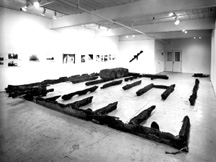- MAIN INDEX | ARTIST INDEX
| February 15 - March 5, 1983 Tom Dean
| |
 Tom Dean, "Floating Staircase", 1983. 18K |  Tom Dean, installation view of "Ruins of the Floating Staircase", 1983. Photo Peter MacCallum. 18K |
| PRESS RELEASE Tom Dean's Floating Staircase was begun in 1978 and completed in 1979. For two years it lived a problematic existence in Toronto harbour, enduring many adventures, some bureaucratic, some natural and some philosophical. In the fall of 1981 it was burned to ashes on the water. This exhibit includes the charred ruins of the Staircase: letters, publications, texts, and photographs relating to its history and a video documenting its rise and fall.
"The Floating Staircase was a device of the imagination so awkward (5 tons, 24 ft. square, floating on 56 oil barrels) that it could not be appropriated by any aspect of our culture. What was explicit in the staircase is perhaps implicit in much of modern art -- its uselessness and essential homelessness. Modern art has tended to express an anachronism. It does not serve a function so much as a kind of dysfunction. It exists as a white elephant, further aggrandised in the white elephant of the art gallery, and succeeds best in reflecting the white elephant inherent in culture. The Floating Staircase reflected the pretention and hope apparent in all our enterprise and culture, not to mock but to affirm its real nature as a monument laboriously, heroically and painfully achieved, immediately inert, and only redeemed by its falling to ashes. "
A thoughtful look at a forgotten hero
John Bentley Mays During the three years of its existence, Tom Dean's Floating Staircase was one of those Toronto facts that wouldn't float away. Whether anchored in Toronto Harbour or in drydock, the 24 foot high, five-ton object was pilloried by art critics, criticised by the harbour police, editorialised about, vigorously defended by art-scene supporters and repeatedly evicted by temporary hosts (such as Texaco Canada). In 1981, the National Capital Commission volunteered to give the massive piece a permanent home, if Dean could get it to Ottawa. Whereupon the artist dutifully remodelled it for its trip up the Rideau Canal - only to find that insuperable financial and technical obstacles still stood in the way. "Only an idiot would endure this creature's demands a minute longer," he recalls saying to himself. In November, 1981, he set fire to the devouring, demanding artifact, and that was the end of that. Well, almost the end. Dean's leviathan, or what's left of it, is currently making one more appearance at Mercer Union (333 Adelaide St. W.). I suspect that even viewers who never thought much of the Floating Staircase - and I include myself here - will find this a rather intriguing show. The charred, rather wistful wreckage of the piece, arranged as carefully as an archeological reconstruction, seems more handsome than the actual staircase ever did. The full story is there, spelled out in official correspondence to and fro, in newspaper and magazine articles, and the various artworks and projects spun off the original big thing. Apart from the charred fragments, however, the best thing in the show is Dean's intelligently lyrical, 22-minute videotape documenting the trials and tribulations of both artist and artifact. Dean's musings carry him from the cultural anthropology of beds to Leni Riefenstahl's Triumph of the Will, but always via his own personal experiences of pain, loss, excitement and distraction. I am not sure how much of this we should take seriously. But when Dean tells us that the creation of the piece was "more like turning a prayerwheel than building an empire," we catch a glimpse of a kind of conviction which wasn't always apparent when the big prop was bobbing around in the water. Incidentally, the staircase wasn't Dean's last hurrah. A teacher at the Ontario College of Art, he intends to go on painting and doing performance works with Toronto dancer and artist Margaret Dragu.
| |